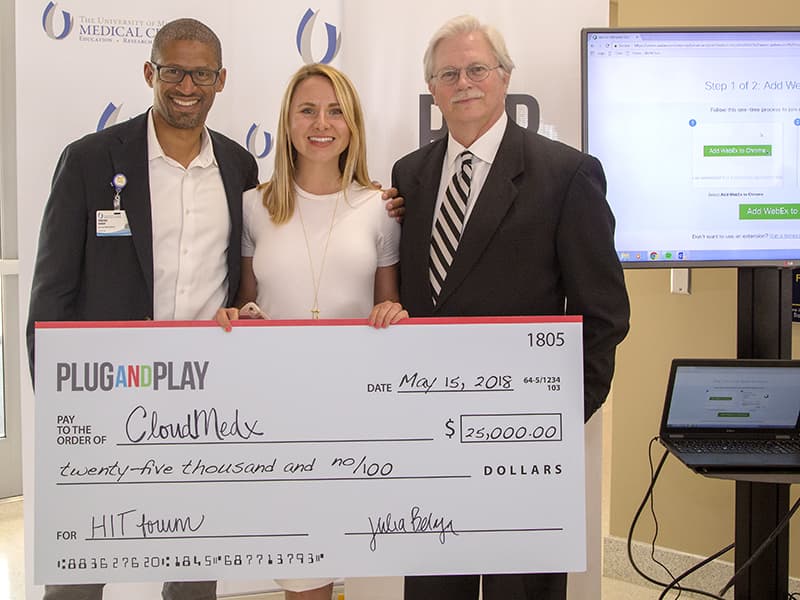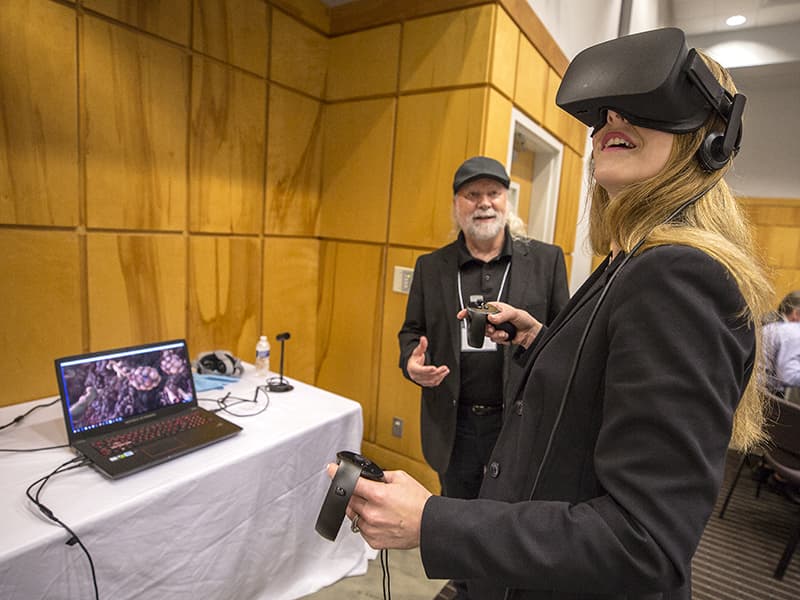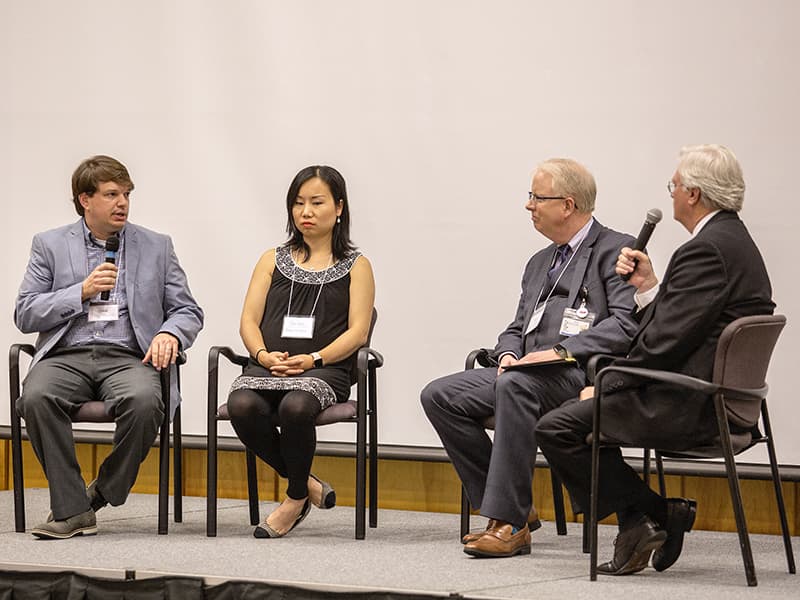Forum a HIT for UMMC's innovation efforts

Five of the most promising technological ideas, each with the potential to greatly improve the health of Mississippians, were pitched in a “Shark Tank”-style presentation to a panel of judges, scientists and industry leaders during the inaugural Health Innovation and Transformation Forum May 15 in the Norman C. Nelson Student Union.
Cosponsored by Plug and Play Tech Ventures, an innovation platform that forges connections between startup companies and the world’s largest corporations, the HIT Forum provided an opportunity for health innovators from the University of Mississippi Medical Center and across the nation to share their ideas to improve health care.
It was fitting, perhaps, that the winner of the pitch competition wasn’t even present at the forum. Tashfeen Sulemon, cofounder and CEO of CloudMedX, a company that offers clinical artificial intelligence to improve patient experiences, was unable to attend the forum in person, but delivered his pitch remotely.
By the time the judges had announced CloudMedX was the recipient of the top prize – a $25,000 investment from Plug and Play, an opportunity to pilot the solution at UMMC, start-up coaching from UMMC’s Health Information and Transformation Center staff, intellectual property review by UMMC’s Innovation, Development and Licensing Office, and a suite in the UMMC Translational Research Center’s business incubator – Sulemon was on an airplane flying to Jackson.

Not having an actual representative on hand to receive the oversized check from Dr. Richard Summers, UMMC associate vice chancellor for research, Terrence Hibbert, UMMC director of innovation, and Julia Belaya, director of corporate partnerships, health for Plug and Play, was symbolic for a competition that in many ways showcased the use of remote systems to improve patient and caregiver interaction.
In fact, the winning concept of the forum’s business plan competition that took place before the event – the Reneker Sensorimotor Error Test and Treat devised by Dr. Jennifer Reneker, UMMC associate professor of physical therapy in the School of Health Related Professions – would rely heavily on UMMC’s Telehealth System to one day deliver expanded comprehensive concussion care to patients throughout the state.
Whether delivered in person or through a computer screen, the pitches all added up to a successful first foray into bridging the innovation/health care divide, Summers said.
“I’m very excited about how this HIT Forum went,” he said. “We had more engagement than we expected. The diversity of people that have attended, from the Mississippi Development Authority, Innovate, the Department of Education, the Ole Miss campus, the Mississippi State campus, the Bower Foundation – all these groups are very important for us to move innovation forward. And our partnership with Plug and Play is very important to the future of innovation at UMMC.
“We want to expand the opportunities and just develop the conversation on our campus of how we can advance the health care system through innovation.”
Summers kicked off the forum by reflecting back on the Medical Center’s storied role in health care innovation, from the world’s first heart transplant into man by Dr. James Hardy to Dr. Arthur Guyton’s mapping of the circulatory system and his world-renowned Textbook of Medical Physiology to the development of the first large-scale computer model of human physiology to, more recently, the development of gene therapy to combat hemophilia B and the discovery of the first functional cure for the HIV virus – albeit temporary – in a human baby.
Summers said the Medical Center has been so technologically productive that a recent nationally published article suggests UMMC provided the most “bang per buck” in terms of innovation and research of any university in the country.
“Mississippi is the epicenter for disease in the country, with poor performance in hypertension, stroke, diabetes and obesity,” he said. “We are at the place where we should be the most influential in terms of treating these diseases through innovation.”

By offering the forum, Summers said the institution is creating the platform for launching innovative ideas. “Otherwise, they’ll never go farther than the conceptual stage.”
He cited the Medical Center’s participation in the ARIC Study, partnership with the Mayo Clinic, the Jackson Heart Study, the Translational Research Center, the John D. Bower School of Population Health, the National Center of Excellence for Telehealth and the Health Innovation and Transformation Center, among others, as major advances in innovation at UMMC.
“The future of medicine is really in our hands,” he said. “We have a chance to do something special, just as we have in the past. Now we can build the infrastructure to do that.”
Belaya, the keynote speaker, provided a brief history of Plug and Play’s development from a real estate company in Silicon Valley in the early 2000s to a corporate innovation provider that has partnered with some of the most well-known companies in technology, from Google and Logitech to PayPal. She said UMMC was the first domestic health care partner for the company, which now sources more than 5,000 startups annually and 700 investments to date.
“At the end of the day, we (Plug and Play) are still venture capitalists,” Belaya said. “To see where to invest our money, we greatly rely on our corporate relationships. We rely on the expertise of our corporate partners. We get feedback from industry experts. We see which companies have the ‘secret sauce’ for us to engage in.
“We look forward to continuing our relationship with UMMC. It’s so exciting to see the innovation continue to grow.”
Hibbert took to the stage to provide an overview of the HIT Center, which just launched in February at UMMC. He explained how the center’s aim is to help patients throughout the state gain greater access to health care in accordance with the vision of “A Healthier Mississippi” advanced by Dr. LouAnn Woodward, UMMC vice chancellor for health affairs.
“In order for us to get to that goal, we’re going to have to do things a little differently than we have in the past,” Hibbert said. “In innovation, you’re either changing your business or you’re changing your technology or some combination of both."
He said the HIT Center has the potential to reshape the patient-provider experience in a multitude of ways, from clinical trials to doctor’s visits, and to enhance disease prevention efforts and the coordinated care of existing health issues.
“There is still a long way to go to create an integrated experience for patients and clinicians,” Hibbert said. “We need everybody in this room to dream it, to design it, to use it. The HIT Center is here to support the change that has to happen . . . We are headed down that path.”
Each participant in the pitch competition was given seven minutes to describe their ideas, followed by a two-minute question-and-answer session with the judges and the audience.
• Dr. Robert L. Hester, UMMC professor of physiology and biophysics and director of the Center for Computational Medicine and Departmental Computer Services, described how browser-based simulation models of HumMod, the most complete mathematical model of human physiology, could be used for education and clinical trials. By developing a medical training product called Sycamore, HumMod could create virtual patients that students could treat in real-time. He said a product called Digital Twin could collect multiple “patient” responses to various treatments and illustrate the expected variability of results on given populations to help find the best results.
• Dr. Jin Lee, CEO of Babynoggin, presented her company’s software, which empowers parents to take an active role in the early health screening of their children. Lee said as many as one in four children are at risk of some form of developmental delay, but only 50 percent of pediatricians in the U.S. – and only 30 percent in Mississippi – have the time to conduct screenings. Lee’s software, Bobynoggin, allows parents to do screenings of their children at home and share the data with health care providers.
• Bilal Qizilbash, a scientist and cofounder of MiraKale Labs LLC, touted the health benefits of kale – particularly in regard to cancer – and suggested a partnership to incorporate dried kale and other healthy foods into Mississippians’ diets.
• Vince Jordan, president and CEO of Lobaki, Inc., an extended reality production studio, demonstrated how a coordinated virtual reality scenario with audio cues for health care providers could help children receive vaccinations and IV lines much more easily. “It would only take 90 seconds to get through this immersive experience,” Jordan said. “We feel like we can materially impact the well-being and the lives of the medical practitioners and the children.”
• Sulemon closed the pitches with his remote presentation of CloudMedX, secure artificial intelligence that could help physicians improve clinical support and documentation and partner with hospitals, patients and developers to provide, analyze and streamline integrated electronic medical record workflows.
After lunch, Dr. Junfeng Ma of Mississippi State University’s Department of Industrial and Systems Engineering provided an overview of how his university is using VR in research projects ranging from design and manufacturing to workforce safety, physician training and clinic patient relaxation. Lee; Dr. Gene L. Bidwell III, UMMC associate professor of neurology; and Dr. Paul Veregge, UMMC chief information officer and chief medical information officer, offered a glimpse into what it takes to bring about a successful tech company during a Fireside Chat moderated by Summers. And Reneker recreated her successful pitch that won the HIT Forum’s business plan competition.
The forum then adjourned to the lobby of the Translational Research Center, where Kevin Cook, CEO of UMMC’s Hospital System, provided a “TED Talk” presentation on the challenges of maintaining a successful business model in a climate of continual technological change, and the pitch competition winner was announced.


